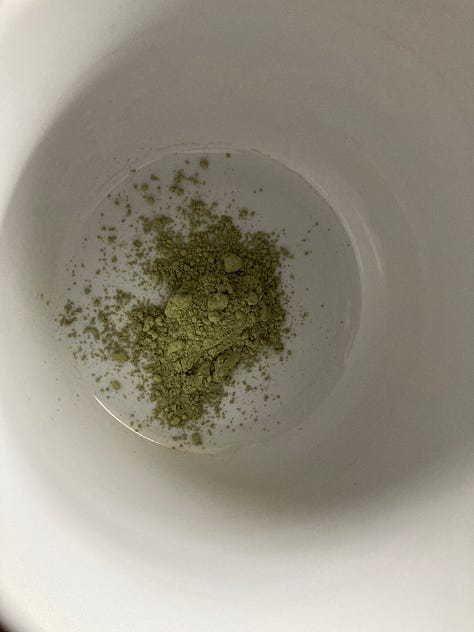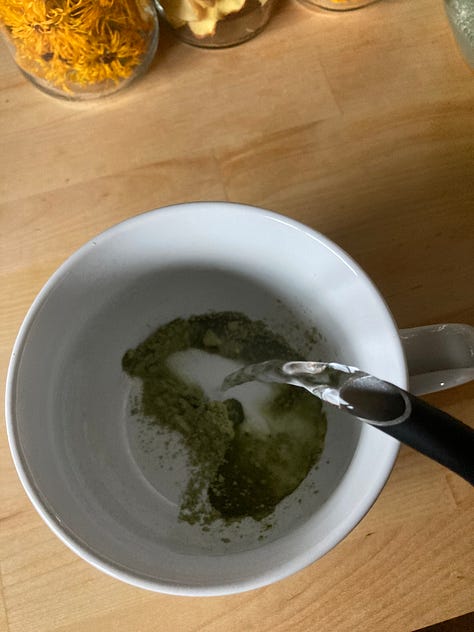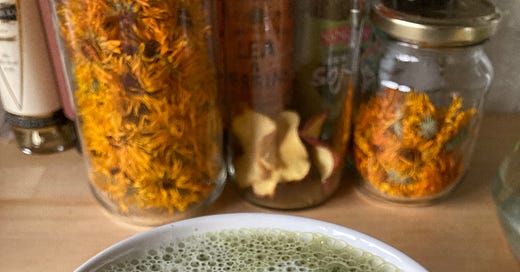🌿 No matter what beverage you decide to make in the morning, slow it down. So often we make our morning beverage without even thinking–often while doing 10 other things at the same time. Slow it down one day this week, observe the whole process with your senses. What’s different?
✒️ “When tea becomes ritual, it takes its place at the heart of our ability to see greatness in small things. Where is beauty to be found? In great things that, like everything else, are doomed to die, or in small things that aspire to nothing, yet know how to set a jewel of infinity in a single moment.” - Muriel Barbery
💡 Japanese tea ceremony has many highly ritualized, precise steps that are enacted by both the person performing the ceremony and the guest. One of my favorite parts is the fact that before the guest drinks, they will notice and reflect upon the warmth of the tea in the bowl, the color of the bright green matcha against the ceramic, the scent of the tea… in other words they bring all their senses into play to be fully present. Connected to not just the tea itself, but also the person performing the ceremony. There is so much more to it than just making and drinking tea.
🍵 The ritual of making Matcha (specifically a Matcha latte) called me this morning. I’m now sipping it while sitting in my favorite spot on the front terrace, watching the birds flit between the roof, orange tree and lemon trees.
From Japan With Love
When I was 17 I lived in Japan, on the island of Kyushu (southern island of Japan) about an hour and a half driving North-East from Nagasaki. I lived in a small town, surrounded by rice fields at the feet of nearby foothills. I moved there for six months on a study abroad with the organization, AFS.
I’d never been to Japan before. I had very little knowledge of the language (I studied it for eight weeks over the summer in an intensive language course at the Oregon State University). But I was fascinated by Japanese history and I wanted to go somewhere I’d never been before, somewhere with a culture that was so completely different from the two places I grew up (USA and Spain). And–a not so small factor–I was privileged enough to have parents that not only could pay for me to go, but also encouraged me to go.
So, in the August before my last year of high school before heading off to University, I made my way to Japan with absolutely no idea where I was going to end up. I’m not really sure what happened, but AFS still hadn’t placed me with a family before I went. So when I finally got off the plane on the island of Kyushu, I’ll admit I was a little nervous about who might be picking me up–if anyone!
I ended up being with a wonderful older couple whose daughter had already moved out of the house years before to make a life in Tokyo. They brought me into their home as a daughter, not just as a person who was staying with them for several months. I wanted to try and learn about as much as possible, and my host parents were more than excited to help me find ways to experience them. They included me in everything they possibly could and went out of their way to make my experience not just memorable, but incredible.
I will always be grateful for that experience and I still hold my host family very near and dear to my heart.
You might be thinking, that’s all well and beautiful, Tess, but why are you telling me this?
I want to paint you a picture of why tea and rituals around tea are so important to me. I’ve always enjoyed drinking tea–especially herbal infusions from things I could pick from the garden–when I was younger. But my real love for green tea and the ritual around tea started when I lived in Japan.
Experiencing Japanese Tea Ceremony
When I was there I joined a tea ceremony club at school–among several others–and did my best to learn the intricacies of Japanese tea ceremony. I’ll not say that I became proficient in them in just the few months that I was there, because I didn’t, but I at least started realizing the beauty behind the ceremony. And over the years, I have come to more fully appreciate how while each precise turn of the bowl or fold of the cloth might seem excessive, there is so much more to it than “this is what you do next”.
The Japanese tea ceremony, called Sado meaning “the way of tea”, began in the sixteenth century and has continued to be an important part of Japanese tradition. It is an aesthetic ritual where tea is elegantly and meticulously prepared and savored, not just for its taste or to wake you up, but for a holistic sensory experience and connection. Connection between you and the tea, and you and the other person.
Throughout the whole ceremony, the idea is to be entirely present with all your senses. Observing the way you move, the heat of the water, the smell of the tea, the way the other person moves, the presence of the space around you, the sounds of the tea being made… and so on. It’s a beautiful, elegant practice that takes years to master. And as mentioned above, I really just had a brief introduction to it while I was in Japan.
I may not remember most of the steps of the ceremony, but the act of staying present with the tea, of connecting to all parts of the tea making process with all my senses has stayed with me.
I’d love to say that every morning I slow things down and take time making my tea. I’d love to tell you that I have committed that ritual to my every morning practice. I can’t.
What I can tell you is that it's part of my practice to continuously come back to remind myself to be more present. To practice, as often as possible, being holistically connected with all my senses, as I make and then drink my teas.
It’s easier to be reminded to do this when I make Matcha because of the steps to mix and froth the tea in the water. And when I have days where I know there is going to be very little time for me, when I know the day is going to be hectic, I do my best to take those couple minutes to make myself Matcha to help me find moments of calm and grounding. This helps me feel more energized and focused as I set out to tackle the tasks of the day.
How to make a Matcha Latte






Matcha lattes might be sacrilegious when it comes to Japanese tea ceremony, but I find the milk helps balance out the caffeine in the matcha (strong caffeine and I don’t always mix–it makes me feel jittery and shaky). Not to mention, they’re just tasty.
What do you need?
Matcha (about a teaspoon but it really depends on how much tea you’re making and how strong you like it)
Hot water (not boiling! Best around 80℃ or 175℉)
A whisk (I use the traditional Japanese bamboo Matcha whisk, Chasen)
Milk (I use either soy or oat milk, but dairy works, too!)
Directions
First and foremost: In each step of the process, connect with your senses (hearing, sight, touch, smell, taste).
Prepare the Matcha:
Sift the matcha powder into a bowl or a large mug to prevent clumping (although I admit, I don’t always sift mine)
Add a little hot water to the matcha powder.
Whisk the mixture in a zigzag motion until it becomes frothy and smooth.
Add in the rest of the hot water to almost fill the mug, but leaving space fo the milk.
Heat the Milk:
In a small pot, heat the milk over medium heat until warm but not boiling. Alternatively, if you have a steamer you can use that, too–this is what I do. (Yes you can also warm it in the microwave… but it’s personally not my preferred choice.)
Optional: Froth the milk using a steamer, milk frother, whisk, or by shaking it in a jar.
Assemble the Latte:
Pour the warmed milk into the matcha mixture. If you’re really talented you can make latte art… I admit, this is not a forte of mine.
Add your desired sweetener if using.
Before you drink your Matcha latte, take time to observe: the warmth of the mug, the color of the matcha against the ceramic, any scents you notice.
When you drink the Matcha latte, take time to observe: the warmth as the tea hits your lips and mouth, the flavors as they first come and perhaps as they change in your mouth, the sensation of the tea as you swallow it, what you can hear around you…
Throughout the whole practice from getting out the mug and ingredients to drinking your tea, take that time for you. It’s a moment to give back to you.
Enjoy your Matcha latte!
Keep reading with a 7-day free trial
Subscribe to Morning Pause 'n Tea to keep reading this post and get 7 days of free access to the full post archives.






